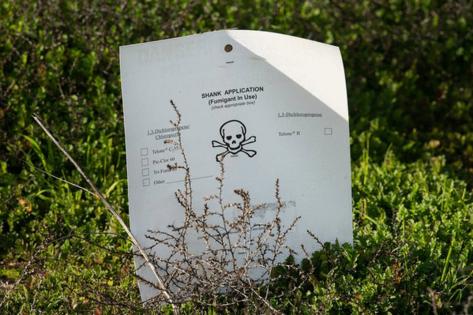California aims to limit pesticide. Central Valley farmworker communities say it's not enough
Published in Science & Technology News
Farmworker communities are protesting the California Department of Pesticide Regulation’s proposal to limit the pesticide 1,3-dichloropropene, arguing the measures don’t go far enough to protect against long-term cancer risks.
Commonly used in agriculture as a pre-plant field fumigant, 1,3-D is injected into the soil, where it turns into a gas that kills plant pathogens like fungi and microscopic worms. However, exposure to the pesticide is linked to an increased cancer risk.
In 2021, at least 1.3 million pounds were applied in Stanislaus County, according to an analysis by Valley Improvement Projects and the Environmental Working Group.
Community members argue that CDPR’s standard is insufficient to protect those exposed. At a public comment hearing in Salinas, residents staged a die-in to protest the proposal. Residents shared stories of losing loved ones to cancer and teachers witnessing students frequently sent to hospital emergency departments for asthma attacks.
Laura Plascencia, community organizer with VIP, said they’ve been recommending and requesting CDPR to follow the cancer risk level set in 2022 by the Office of Environmental Health Hazard Assessment.
Another concern is that DPR’s proposal accounts for only 40 years of work and assumes standard hours from 8 a.m. to 4 p.m., which Plascencia said is “not representative of reality.” She explained that most farmworkers work longer hours and for more years, calling DPR’s calculations conservative.
Mark Weller, campaign director and Interim co-director for Californians for Pesticide Reform, who was at the hearing in Salinas, pointed out that the most affected communities are disproportionately Latino and Indigenous.
“I think people are just showing that they had enough,” Weller said.
At a Stanislaus County Emissions Reduction Projects meeting in Turlock on Wednesday, several Turlock schools were identified as being at risk for pesticide exposure due to their proximity — within a quarter mile — of agricultural fields. These schools include Cunningham Elementary, Roselawn High, Walnut Elementary and Pitman High.
Health impacts of pesticide exposure include low birth rates, asthma and effects on the cardiovascular and respiratory systems, said Plascencia. She also added that 1,3-D can also harm plants by reducing their ability to absorb nutrients from the soil and weakening their resilience.
Stanislaus County’s air monitoring study results are pending
Last year, CDPR conducted a study in Stanislaus County to measure the air concentrations of the pesticides 1,3-D, chloropicrin and methyl isothiocyanate. These concentrations will be compared to human health screening levels.
Stanislaus County Agricultural Commissioner Linda Pinfold said the results of the study should be available in a couple of months and will provide more insight into whether pesticide levels in the county pose health risks or contribute to serious illnesses or fatalities.
She added that it would be reassuring if the results show no immediate concern, but emphasized that community concerns remain important.
“We’re trying to work with everybody to ensure that pesticides are used safely, effectively, and that everybody’s protection is being considered. Human health is paramount,” Pinfold said.
A second draft of DPR’s proposal is expected around June, and Weller hopes it will reflect the community’s concerns.
“If it’s not what we want, I think you’re going to see much bigger protests than you saw this time,” Weller said.
Plascencia said there is a need for more investment in understanding the effects of pesticide contamination. She also highlighted the importance of advocating for more sustainable agriculture practices and pushing DPR to invest in alternatives.
She added that while California is more progressive, it still isn’t fully protecting residents from these risks.
“It just seems like there isn’t enough priority to start looking into alternatives,” Plascencia said.
_____
©2025 The Sacramento Bee. Visit sacbee.com. Distributed by Tribune Content Agency, LLC.







Comments